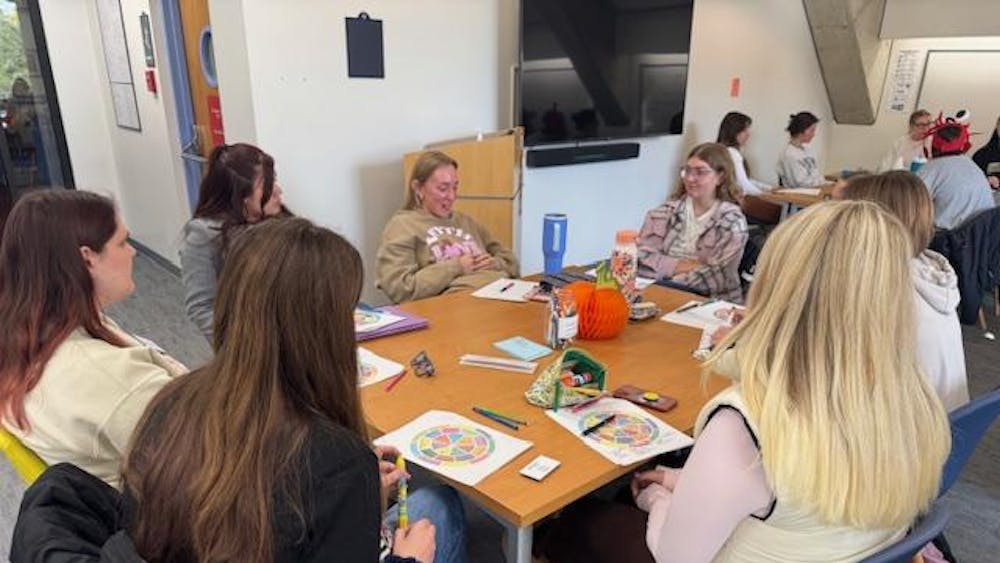A panel discussion hosted by the Kaneb Center on Tuesday covered various faculty members’ experiences teaching college-level courses at the Westville Correctional Facility, a medium-level security institution southwest of South Bend.
The panelists included Maria McKenna, an education and Africana studies professor, Kaneb Center fellow and English professor Kate Marshall, the William R. Kenan, Jr. professor of English Valerie Sayers and Daniel Graff, director of the Higgins Labor Program.
The panelists began their discussion explaining their own personal reasons for wanting to teach at Westville. Each panelist explained their own beliefs regarding the Westville Education Initiative (WEI), the importance of “practicing what you preach” and making a difference in an individual inmate’s life. They each stressed the importance of recognizing that teaching at Westville was not engaging in prison reform — it was simply teaching a class to college students.
The audience at the event was primarily composed of faculty members and graduate students, who were able to ask panelists questions throughout the event. Many of the questions from faculty members were about the logistics of teaching at Westville and future opportunities to teach there.
One faculty audience member, who currently teaches chemistry at Westville, discussed the differences in teaching Notre Dame undergraduates and prison inmates. For him, the primary difference is the background of his students. Most of the Westville inmates enrolled in the educational initiative hold a GED rather than a conventional high school diploma.
Marshall elaborated on the differences between teaching at Notre Dame and Westville, but said it is important for professors to plan their classes at Westville in the same manner they plan courses at the University. When a professor teaches in Westville, he or she is in a room full of intellectual people with varying levels of preparation, Marshall said. The difficult part, she said, is reconciling the “incredible intellectual capacity that didn’t always have the same kind of preparation, the same kind of resources, going into that [program] that our students have”.
Graff discussed the logistical differences between teaching at the University and Westville, such as restricted internet access, a lack of email access and limited access to the professors. However, he said the realities of these problems were much more hard-hitting than he had expected. In adapting coursework, he ended up “jettisoning” the lecture component of his class and focusing on discussions, as inmates were “faithful readers” and very eager to discuss in class.
He also discussed the challenges of teaching in a prison, as correctional officers would often interrupt class or remove inmates from the classroom for unknown reasons. Sometimes, professors would arrive at the prison after a long commute only to be told that classes had been cancelled for the day.
Sayers, who teaches fiction literature and literary analysis at the prison, said that during literary workshops in class, it was very difficult for inmates to critique one another’s work, due to the proximity in which they live.
“One thing that intrigued me was that they seemed just as interested in grades as Notre Dame students,” she said, drawing laughter from the crowd.
Classes at Westville are held once a week, and the course schedule mostly maps on to the academic schedule of Holy Cross College, Marshall said. Many times, the door-to-door time commitment for professors involved in the program is six hours, she noted.
Stephen Fallon, a professor in the Program of Liberal Studies and English department, said the prison initiative offers a unique chance for instructors to engage with particularly motivated students.
“I think it’s both an exciting opportunity for the students out at Westville and it’s a really exhilarating opportunity for the faculty at Notre Dame,” he said. “They’re able to do very high level teaching, with an entirely different population, who are extremely eager to have it. They weren’t expecting to be in college, and now are thrilled to have real Notre Dame professors in the classroom with them, and they don’t just express gratitude in words — they do so by working very very hard.
“And I find that when I make an assignment, they’ll have read more than I asked them to read. They’ll go on and read beyond the assignment and have questions sometimes about things I haven’t read, so it keeps me on my toes, and it’s a kind of teaching where I very much look forward to my class each week.”
The object of the program is to give inmates the opportunity to earn at least an Associate’s Degree, and the program is one of the only in the country to offer a Bachelor’s Degree. As such, inmates need to be serving a longer sentence (three to ten years) in order to have enough time to complete the degree. Usually, around 150 applicants apply, and the admissions rate to the program is around 20 percent, Alesha Seroczynski, the WEI director of college operations, said.
Sayers said the program complements an undergraduate course, “Rethinking Crime and Justice: Explorations from the Inside-Out,” wherein students participate in a class alongside Westville inmates.
“I think the work the faculty does teaching the college courses dovetails beautifully with the work that undergraduates do in their ‘Inside-Outside’ course,” Sayers said. “They’re two entirely separate programs but I’ve talked to several students who’ve done the course and we’ve had many of the same insights about how powerful and satisfying and challenging it is to go out to Westville on a regular basis, and how it is a really transformative experience for faculty and students alike.”
Professors discuss Westville Education Initiative
Professors discuss their
Professors share their experiences instructing courses through the Westville Education Initiative during a panel in Corbett Family Hall on Tuesday night. The program allows prison inmates to pursue a degree in higher education.









